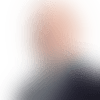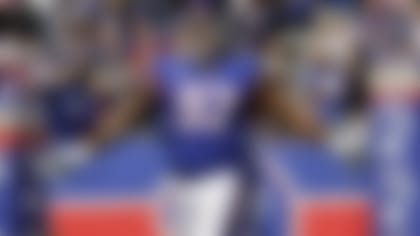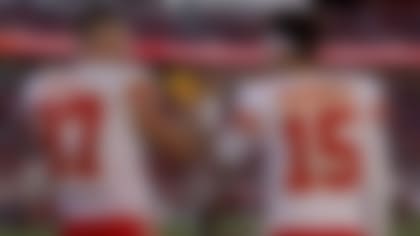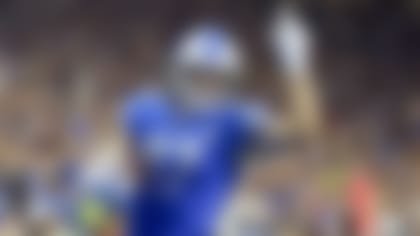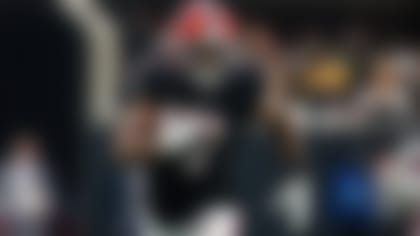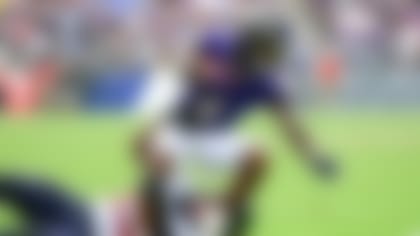The beginning of every league year brings newfound hope in the form of veteran free agents. Whether your team is rebuilding its roster or adding a few missing pieces for a playoff run, the infusion of proven talent promises that this year will be better than the last.
That's the way free-agent acquisitions are sold in March. By the time November rolls around, NFL fans are reminded of the reasons those players were deemed expendable by their former teams. More often than not, exchanging teammates, coaches and schemes leads to unfulfilled expectations.
There are also the regrettable re-signings, guys who inked a new contract with the same old team ... before playing at a level that induces instant buyer's remorse.
With all of that in mind, let's examine this year's top free-agent flops:
1) Brock Osweiler, QB, Houston Texans: Nine games into his Texans career, Osweiler represents one of the trickiest franchise question marks in the league. After scapegoating Brian Hoyer and billing Osweiler as the savior this past offseason, Houston ranks 30th in offense while its quarterback ranks dead last in Pro Football Focus' grades and Gregg Rosenthal's meticulously curated QB Index. A lumbering Osweiler has yet to demonstrate the accuracy, field vision, pocket movement and streamlined delivery of a franchise player. By any measure, he represents a clear downgrade on Hoyer.
How problematic has Osweiler been? He's coming off one of the least-efficient three-game stretches in modern history. In fact, Lamar Miller is averaging more yards per rush attempt (4.65) than Osweiler has averaged per pass attempt (4.29) over the past three weeks. At 5.8 YPA, Case Keenum is the closest to Osweiler's futility level since Week 7. The Rams have turned to No. 1 overall draft pickJared Goff as Keenum relief. The Texans, meanwhile, are stuck with a $72 million boondoggle.
2) Ryan Fitzpatrick, QB, New York Jets: It was telling that not a single NFL team was willing to pay Fitzpatrick more than backup-quarterback money after he produced one of the best statistical seasons in franchise history. The Jets could have pulled the plug on their protracted offseason standoff with Fitzpatrick by signing a quarterback of similar talent and production, such as Hoyer. Instead, they tried to squeeze one more season out of an aging roster, hoping Fitzpatrick could repeat his 2015 Fitzmagic.
For $12 million, the Jets purchased the league's interception leader, benched once for Geno Smith and likely to be remaindered soon in favor of a raw project in Bryce Petty. Fitzpatrick's Week 5 touchdown pass to Brandon Marshall perfectly encapsulates the conundrum he presents as an NFL starting quarterback. It was an underthrown pass that should have been intercepted -- a chance many signal callers wouldn't even attempt -- but his power-forward receiver bailed him out by jumping over the top of cornerback Ross Cockrell to wrestle the ball free. That's not a recipe for long-term success.
3) Coby Fleener, TE, New Orleans Saints: When the Saints lured Fleener to the Big Easy with a five-year, $36 million deal, he was billed as a playmaking upgrade on departed veteran Ben Watson. Fleener was supposed to make magic with Drew Brees, terrorizing defenses down the seam while calling to mind the halcyon days of Jimmy Graham.
Needless to say, that has yet to happen. After failing to find a rapport with Brees in training camp, Fleener took a backseat to the wide-receiver trio of Brandin Cooks, Michael Thomas and Willie Snead early in the season. Since the Week 5 bye, he has fallen even further in the pecking order, losing snaps to Josh Hill. A team fielding a perennially poor defense can't afford to be throwing money at afterthoughts on offense.
4) Russell Okung and Donald Stephenson, OTs, Denver Broncos: While the rest of the football world sounded the alarm bells at quarterback, general manager John Elway prioritized his offensive line in free agency. Okung and Stephenson were signed as book-end tackles, billed as major improvements over the 2015 duo of Ryan Harris and Michael Schofield. That hasn't been the case.
Stephenson has been one of the league's least effective right tackles, earning a Week 10 mercy benching at the hands of disruptive Saints defensive end Cameron Jordan. Okung hasn't been much better, committing too many penalties while allowing consistent pressure. Against a New Orleans pass rush that is hardly nightmare fuel, Trevor Siemian was sacked six times, hit six more times and pressured on 22 of 48 dropbacks. The run blocking has been just as inconsistent, disappearing for long stretches of the season. Elway was right: The offensive line has been more of a competitive disadvantage than the neophyte quarterback.
5) Chris Ivory, RB, Jacksonville Jaguars:Blake Bortles' shocking regression has overshadowed Jacksonville's disappointing, 26th-ranked backfield. Signed away from the Jets, Ivory was handed north of $6 million per year to complement T.J. Yeldon as a red-zone weapon and between-the-tackles battering ram.
After missing the first two games with an emergency medical condition, Ivory hasn't been the same ferocious, tackle-breaking machine we're used to seeing early in the season. He's found paydirt only once this year while averaging just 38 yards per game. Like the rest of Jacksonville's ballyhooed free-agent class, Ivory hasn't played up to his contract.
6) Robert Griffin III, QB, Cleveland Browns: To quote Around The NFL's resident wordsmith, Marc Sessler, the Browns entered the offseason needing a franchise quarterback "like the Earth needs the sun." Rather than hitching his star to a bright prospect such as Carson Wentz, new coach Hue Jackson was swayed by a private March workout with an allegedly rejuvenated Griffin. "It felt like the Earth moved beneath my feet," Jackson apparently exclaimed at one point.
Incumbent starter Josh McCown wasn't afforded a fair shot under Jackson, as Griffin was shoehorned into the QB1 role after mixed reviews in offseason practices. The NFL's most reckless, fragile quarterback lasted just one game in Cleveland before a shoulder issue sent him to injured reserve. Jackson has cycled through passers ever since, playing four different quarterbacks (plus Terrelle Pryor) while still seeking his first win with the Browns.
7) Dwayne Allen, TE, Indianapolis Colts: We've been waiting four years now for Allen to develop into a Pro Bowl-caliber tight end, an asset as a receiver as well as a blocker. When the Colts allowed Fleener to walk, they re-signed Allen to a four-year, $29.4 million deal in hopes that he would finally reach his potential in an offense shifting to more one-tight end sets.
Allen is being paid like he's Delanie Walker. Instead, he remains injury-prone and inconsistent, outplayed by undrafted (in 2013) Jack Doyle -- a more reliable and trusted outlet for Andrew Luck.
8) Arian Foster, RB, Miami Dolphins: The Dolphins can't help themselves; they are hooked on free-agent veterans with marquee names who have outlasted their fading games. Even though the Texans castoff had shown nothing to make one believe he could remain healthy and productive at age 30, coach Adam Gase was determined to feature Foster in his new offense.
The true foible wasn't shelling out money for Foster. It was blocking the path of Jay Ajayi, who has proven to be a prototypical power back capable of carrying an offense and keeping the defense off the field. Would Miami's four-game winning streak be a six-game streak had the Dolphins resisted the dalliance with Foster and saddled up Ajayi earlier in the season?
9) Andre Smith, OT, Minnesota Vikings: The Vikings had the right idea: import veteran maulers such as Smith and Alex Boone, thereby unleashing Adrian Peterson behind a stout offensive line, perfectly complementing a ferocious defense. They just picked the wrong player. Struggling to beat out an overwhelmed T.J. Clemmings at right tackle, Smith was a liability for a month before going down with a season-ending triceps injury.
About that plan for a dominant ground attack? Minus Peterson and their top three tackles, the Vikings are averaging a feeble 2.7 yards per carry. The last time an NFL team failed to reach 3.0 yards per carry for the entire season was 1994.
10) Rueben Randle, WR, Philadelphia Eagles: Attempting to fill a glaring need for an experienced receiver capable of stretching the field outside the numbers and down the middle, the Eagles signed Randle away from the division-rival Giants on a one-year prove-it contract with $500,000 in guarantees. Randle arrived carrying a reputation as a sloppy route runner with a penchant for tardiness in team meetings.
By the time preseason action rolled around, Randle was taking flak from the local media for a lack of effort. The Eagles promptly cut Randle at the end of training camp, leaving rookie Carson Wentz with Jordan Matthews and a passel of unreliable second fiddles at wide receiver. By the trade deadline, general manager Howie Roseman was trying to pry Torrey Smith away from the 49ers in an effort to shore up an underperforming wide-receiver corps.
